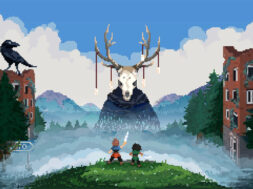From Software has done it again. Find out why this trip to ancient Japan is worth your time in Bloody Disgusting’s Sekiro Shadows Die Twice review.
Sekiro: Shadows Die Twice is quite different from its spiritual elder siblings, but it still captures something rather important that is found in all of them.
In the last ten years of From Software games, there’s that special moment where the relative calm of the opening moments is clearly about to end and you take a hesitant step towards what will be the first of many, many challenges. The excitement comes from not knowing exactly what’s next and how you can get past it.
The learning experience of each battle, each failure, each triumph, is the intoxicating lifeblood of Demon’s Souls, Dark Souls, Bloodborne, and now Sekiro. The world is broken and enchanting, but when your sword is raised to meet your opponent, that melts away into intense, brutal, and highly satisfying combat.
Sekiro is From Software’s latest unforgiving opus. Set in ancient Japan, you are a Shinobi, tasked with rescuing your Lord and master (a child of an important bloodline) and venture through a world on fire thanks to the ongoing war. Gone is the very European fantasy style of the Souls games and the Gothic horror of Bloodborne, now there’s a more historical reality to your surroundings, albeit tinged with some fantastical elements that become more apparent as you progress.

There’s a bit of the looping back to old areas you’d expect, but this is a sprawling world, cut into large segments in a rather subtle manner. Exploration is thoroughly rewarding here too because there are so many hidden paths and areas that require a keen eye. Even before the later parts of the game throw some striking examples of scenic variety your way, there’s plenty of detail and difference in each place you visit.
What’s immediately alarming to seasoned Soulsborne players is discovering there is just one character, with a name and a voice, and that there’s no stamina bar, no classes, and no different weapons. Everyone gets the same starter pack of skills and abilities. There’s no multiplayer summons, no messages from other players to give hints (or be devious), and if you’ve been comfortable with shields and slow caution? Sorry bub, not happening here.
This makes it sound like quite a radical departure, and beneath the surface it really is, but as noted before, the ‘Soul’ of what makes From Software’s games tick is still very much there, it’s just been refashioned into something new and exciting. So don’t be surprised when Sekiro rejects much of what you’ve learned in Soulsborne games, it may take a while to adjust, but a time comes where you have the revelation regarding how you should be approaching Sekiro. Then it’s like slipping into a silky and somewhat comfortable gown, albeit one that has rose thorns randomly taped to the inside.
Sekiro himself is an agile protagonist, so also fresh for a From game is a newfound verticality to the game world. You can jump, climb, and using your Prosthetic Shinobi arm (you lose your real arm early on), grapple up and across distances. This agility plays directly into the combat itself. You can and will have to be measured and methodical in sparring at times, but there’s a need for quick reactive maneuvers for most fights, with dodging, jumping, and parrying all playing a huge part in how long you’ll hold out, and emerge victorious when you hit that final, decisive deathblow by driving your sword through their flesh.

Being defensive is part of your skillset, but it’s far more important to keep engaged in a battle so you don’t let the enemy regain their posture by sitting back and being too cautious. Basically, defensive play in Sekiro often means getting up close and personal when your Soulsborne-trained mind is screaming at you to keep your distance.
You get through even the smallest battles by the skin of your teeth, death almost always just one wrong move away. Boss fights and mini-boss fights especially play out like a remarkably perfect blend of sports game and rhythm game. The prompts for enemy attacks are friendlier on the eye than most From Software titles, but Sekiro still requires you to remember the patterns and adopt a plan for victory through the magical learning experience that is repeated failure. As you advance deeper into the game and face new obstacles whilst wielding new instruments of death, the silky violent energy of it all remains as fresh and exhilarating as it did in the first hour.
There’s a gratifying sensation gained from soaking up attacks with well-timed parries and dodges, damaging your opponent’s posture until the point they’re opened up for a killer deathblow. Same goes for driving an opponent into a corner after swiftly nullifying their attacks, and also for utilizing the various abilities your prosthetic arm can offer you.

The prosthetic arm is not just for swinging about on you see. It can be fitted with special tools that hold distinct advantages against certain enemy types. You start with a shuriken-throwing arm, which is useful against archers early on, and then by exploring the world, you can discover more variants. Learning from your failures often means learning which arm tools to pack for the occasion.
Mercifully, Sekiro offers some ‘easier’ ways to deal with problems. Stealth can be employed a fair bit, which allows you to circle round tougher enemies and give you a free, unchallenged deathblow, but such opportunities are not always present. You’re only sometimes locked in an enclosed ground fight with bosses in Sekiro, so it’s a relief to be able to pull back from a tough fight and revisit your strategy when things aren’t going so well. In fact, you can in some cases, hide for long enough that enemies forget you, allowing you to effectively have a do-over. Boss health does reset if you wait after taking off the first health bar by sneaky means, so you can’t rely on just creeping back and forth in those cases so much.
There’s no denying Sekiro is tough, but it is at least mostly dependent on your abilities, so it is a fair sort of toughness. There are boss fights and gauntlets that will likely leave you screaming at the screen in frustration, but it’s almost never the fault of the game. The exception here is when the camera gets caught in tight corners or you’re dealing with a fast enemy. Thankfully this is an infrequent issue, but little is more agonizing than doing well in a fight, only to have a camera issue take you out of your stride.
Those boss fights, big and small, are pretty much always litmus tests of your current comfort level with the game and its systems. They offer up a collection of weird, wonderful, and downright disturbing encounters (a battle against a certain boss in a mountainside cave comes to mind). Many overwhelm with their raw speed and power when you first meet them, but it just makes their eventual downfall all the sweeter. Some of the more sword-based fights are exhilarating and intense to the point that sweat pours and the heart rate rises. Near the game’s end, you’ll be chaining parries and strikes at an alarming rate, barely surviving multiple rounds of a fight against single opponents.
There are so many exceptional boss fights in Sekiro. It’s a testament to the game’s design and mechanics that duels with human characters can be just as remarkable as those against the more beastly and supernatural. They don’t even follow the same system of whittling down a health bar every time, and in one boss fight, in particular, it’s all about using stealth to avoid instant death before eventually landing that satisfying deathblow. Its roaring anguish as it thrashes about is mesmerizing. It’s truly the first time the game throws something really different at you, and it’s always welcome when such oddities occur from that point on.
There’s some boss repetition, but From Software does try to provide a neat twist for the second encounters where possible. Unfortunately, some are just unwelcome returning guests, plopped into a new kind of area without much changed in their patterns When a very early mini-boss showed up again late in the day, I groaned because it had been the most unpleasant part of my early time in the game, and this time, it just simply wasn’t fun.

A final, rather small, complaint is in the early hours, having mini-bosses surrounded by regular enemies can truly test your patience. There’s little hope of taking on all of them, and one wrong move means you can end up having to do exactly that, which typically means you end up having to repeat that section, carefully culling their numbers before having a swipe at the mini-boss. It can be a tad disheartening, especially when learning how exactly Sekiro plays. It wasn’t enough to put me off, but I can see how it might do for others.
It’s really a miniscule set of complaints in the grand scheme of things. I’d personally been burnt out by the Souls formula after enduring Dark Souls III‘s aggravating final hours, so I came to Sekiro unsure if I’d enjoy it. To my surprise it was intoxicating. By giving the player more mechanical flexibility and stripping back the RPG side, this sleeker beast is at home in From’s modern library of titles, but is the most strikingly different of the lot.
After over 70 hours I still want more of Sekiro, and happily, there is more to be done in this world after the natural end. Once the systems clicked, I was dragged deep into the game, and it filled my thoughts every time I was away from it.
Sekiro is a beautiful, brutal ballet of butchery. It enthralls not only with its magnificent game world, but with a combat system that continually thrills as it evolves.

Sekiro Shadows Die Twice review code on PS4 provided by the publisher.
Sekiro Shadows Die Twice is out now on PS4, Xbox One, and PC.









